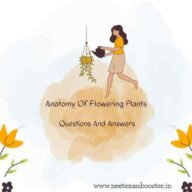Plant Kingdom Class 11 Introduction
Plant Kingdom Class 11:-
Plant kingdom includes numerous herbal sources.The classification of all plants in kingdom plantae is according to their characters.
- This kingdom includes Algae, Bryophytes, Pteridophytes, Gymnosperm, Angiosperms.

Plant Kingdom Class 11 Important Short Questions And Answers
Q.1. Which algal group has mannitol as the reserve food material?
A.1. The algal group Phaeophyceae or the brown algae has mannitol as the reserve food material.
Q.2. Write the name of the plants with
- Haplontic life cycle
- Diplontic life cycle
- Haplo-diplontic life cycle
A.2.
- Haplontic life cycle- Volvox,spirogyra
- Diplontic life cycle- All seed-bearing plants such as gymnosperm and angiosperms
- Hapiodiplontic life cycle- Bryophytes and pteridophytes
Q.3. Roots are used for the purpose of absorption of minerals and nutrients.Which part of the plant is equivalent to roots in less developed lower plants?
A.3. In the less developed lower plants rhizoids are the root-like structures present. For eg., in bryophytes and pteridophytes.
Q.4. What is the male and female sex organs in Bryophytes are known as ?
A.4.The male and female sex organs in Bryophytes are known as antheridium and archegonium.
Q.5. Match the given one:
| Column I | Column II |
| Cycas | Pteridophytes |
| Chlamydomonas | Moss |
| Selaginella | Algae |
| Sphagnum | Gymnosperm |
A.5. Cycas-Gymnosperm Chlamydomonas-Algae Selaginella-Pteridophyte Sphagnum-Moss
Q.6. In which kingdom Cyanobacteria are classified?
A.6. Under kingdom Monera.
Q.7. What is anisogamy?
A.7. Anisogamy is a type of sexual reproduction which involves the fusion of two motile gametes that are dissimilar in size.
Plant Kingdom Class 11 Quiz
Q.8. An embryo sac is made up of how many cells?
A.8. Embryo sac is made up of two synergids, one egg cell, three antipodal cells, and one secondary nucleus,total 7 cells.
Q.9. Which three groups of plants bear archegonia?
A.9. Bryophytes, pteridophytes, and gymnosperms are three groups of plants that bears archegonia.
Q.10. What’s the reason for both gymnosperms and angiosperms in spite of both bearing seeds?
A.10. This is because in gymnosperms the seeds are not present inside the fruit, while in angiosperms they are enclosed inside the fruit.
Q.11.Define an artificial system of classification.
A.11.The artificial system of classification of Plant kingdom is based on the vegetative characters and androecium structure.
Q.12.Write the Botanical name of sea palm.
A.12. Botanical name of sea palm is Postelsia palmaeformis.
Plant Kingdom Class 11 Notes
Q.13.What is meant by Chemotaxonomy?
A.13. It is defined as the method of biological classification based on similarities of the chemical constituents of the plants.
Plant Kingdom Class 11 – Short Answer Type Questions
Q.1.Bryophytes considered amphibians of the plant kingdom why?
A.1. Bryophytes considered as amphibians of the plant kingdom because they depend on water for male gametes movement called antherozoids to reach archegonium for fertilization.
Q.2. Distinguishe the various reproductive parts of the pteridophytes and gymnosperms with those of angiosperms.
A.2.
| Reproductive parts of the pteridophytes and gymnosperms | Reproductive parts of the angiosperms |
| Cone | Flower |
| Megasporophyll | Anther |
| Megasporangium | Ovule |
| Microsporangium | Stamen |
| Microsporophyll | Pistil/Carpel |
Q.3. How does the heterospory have some evolutionary significance in the kingdom plant?
A.3. Pteridophytes are the intermediate between bryophytes and gymnosperms. Primitive pteridophytes are homosporous but the later pteridophytes are heterosporous. The bryophytes are homosporous and gymnosperms are heterosporous.
Plant Kingdom Class 11 Toppers Notes
Q.4. Selaginella fall short of seed habit .How far does it?
A.4. It gives rise to the two kinds of spores, megaspores and microspores. It’s spores germinate and give rise to male and female gametophytes. But, due to integument lack around the megasporangium, Selaginella falls short of seed habit.
Q.5. Describe the phylogenetic relationship of Cycas with another group of plants.
A.5. Cycas is an evergreen plant it looks like a palm tree. It exhibits a phylogenetic relationship with pteridophyte. The evolutionary characters may include:
- Shedding of seed when the embryo is getting immature.
- It have slow growth.
- Monocyclic wood.
- Little secondary growth.
- Leaf-like megasporophylls.
- Circinate ptysix.
- Persistent leaf bases.
- Arrangement of the microsporangia is well-defined archegonia.
Q.6. Explain the life cycle as well as nature of a fern prothallus.
A.6. The life cycle of Prothallus: The life cycle of the fern exhibits alternation of generations. The prothallus of fern is multicellular, free-living, haploid, autotrophic, and thalloid structure. It developed from the produced spore after reduction division by saprophyte. Germ tube germinate these spores. 3-6 cells filament forms and rhizoids on the base which develops into a gametophytic plant later.
Q.7.Write difference between the male and female gametophytes of pteridophytes and gymnosperms.
A.7. Male Gametophytes:
| Gymnosperms | Pteridophyte |
| A distinct male gametophyte is present. | A distinct male gametophyte absent. |
| Antheridium is absent. | Antheridium present. |
| Male gametes may or may not be flagellated. | Flagellated male gametes |
| Male gametes reach the female gametes through a pollen tube. | Male gametes reach to the female gamete through the flowing in water. |
Female Gametophytes:
| Gymnosperms | Pteridophyte |
| A distinct gametophyte present. | A distinct gametophyte may or may not be present. |
| Female gametophyte not leave the parent plant. | It is independent to the parent plant. |
| An ovule enclosed inside. | Not enclosed inside the ovule. |
Q.8.In which plant Mycorrhiza and coralloid roots are found ? What do these terms mean?
A.8. Mycorrhiza is a symbiotic association between fungus and roots of vascular plants. This association is present in conifers such as Pinus, Cedrus, etc. Coralloid roots are present in the Cycas plant. Coralloid roots are in clusters at the base of the stem and protrude over the ground. It is green in colour and dichotomously branched.
Q.9. Heterosporous pteridophytes exhibit certain characteristics which are precursors to the seed habits in gymnosperms. Explain.
A.9. Heterospory is the production of two types of spores; the megaspores and the microspores. The male gametophyte produced by microspores which produces male gametes, while the megaspores produce female gametophyte which produces archegonia and it provides nourishment to the embryo. Heterospory leads to a reduction of the gametophyte.Heterospory in pteridophytes forms the base of seed habits in gymnosperms.
Q.10.Write the importance of Algae.
A.10.
Algae are economically important in different ways and are discussed as:
- Helps in carbon dioxide fixation in the soil or in the environment.
- It is the simplest form of producer in a food chain.
- It helps in increasing the dissolved oxygen level in the environment.
- Algae used as a source of food.
- It is a source of crude oil and also in many pharmaceutical and industrial products which is used by humans.
Plant Kingdom Class 11 – Long Answer Type Questions
Q.1. Gametophyte is a dominant phase in the life cycle of bryophytes. How ?
A.1. It bears the male reproductive organ i.e antheridia and female reproductive organ i e archegonia, thereby producing male gametes (antherozoids) and female gametes (egg cell). A gametophyte is a dominant form and the most common phase of the life cycle of bryophyte. The antherozoid fused with the egg to produce a zygote. Zygote forms a multicellular body called as the sporophyte.
Q. 2 Explain the life cycle of a plant.
A.2. The life cycle of a plant starts from a seed. The seed germinates and grows as a plant. The plant produces flowers which form seeds in fruit on fertilization. The plant dies and leaves seeds behind which germinate to form new plants.
Q.3. What is double fertilization and triple fusion?
A.3. The process in which one male gamete fertilizes the egg and forms a diploid zygote.And the other male gametes fuse with the two polar nuclei to form a triploid zygote that develops into the endosperm. This is called as double fertilization. The three haploid nuclei fuse to form an endosperm. It is called as triple fusion.
Q.4. What is meant by parasitic algae?
A.4. Parasitic algae are also called as the common plant pathogen. These species of algae are commonly seen in warm, humid climates and are generally found in the leathery leaf plants such as litchi, hollies, magnolias, and viburnums. Parasitic algae are the main causes for foliar disease and red rust of tea leaf. Cephaleuros is an example of parasitic green algae.
Click here and join our telegram channel for more important study materials like Plant Kingdom Class 11 important questions and answers.





 155 out of 200 questions were directly asked from these notes in NEET 2024
155 out of 200 questions were directly asked from these notes in NEET 2024
